Stony-iron meteor caused August impact flash at Jupiter
Analysis of a bright flash in Jupiter’s atmosphere observed by an amateur astronomer in August 2019 has revealed that the likely cause was a small asteroid with a density typical of stony-iron meteors. The impact is estimated to have released energy equivalent to an explosion of 240 kilotons of TNT – around half the energy released in the 2013 Chelyabinsk event at Earth. The results have been presented today at the EPSC-DPS Joint Meeting 2019 in Geneva.
Ethan Chappel from Cibolo Texas captured a short flash of light at 04:07 UTC on 7th August in video observations of Jupiter using a small telescope in his backyard. The flash lasted for about 1.5 seconds and, at its peak, appeared as bright as Jupiter’s moon Io. Chappel continued his observations for the next half hour without knowing he had been the only witness of a planetary collision.
Once inside, Chappel analysed the video data using DeTeCt, an open source software specially designed to identify impacts in Jupiter. On finding a clear image of a flash in one of the videos, he quickly got in touch with the developers of the DeTeCt project, Marc Delcroix and Ricardo Hueso, who in turn contacted their large network of amateurs to see if any other detections had been made.
Marc Delcroix, a French amateur astronomer, said: “I was thrilled when Ethan contacted me. This is the first impact flash at Jupiter found using the DeTeCt software. These detections are extremely rare because the impact flashes are faint, short and can be easily missed while observing the planets for hours. However, once a flash is found in a video recording it can be analysed to quantify the energy required to make it visible at a distance of 700 million kilometres.”
Over the past month, Ramanakumar Sankar and Csaba Palotai of the Florida Institute of Technology (FIT), have made an in-depth analysis of the data. They estimate from the energy released by the flash that the impactor could have been an object around 12-16 metres in diameter and with a mass of about 450 tons that disintegrated in the upper atmosphere at an altitude of about 80 kilometres above Jupiter’s clouds. Sankar and Palotai’s models of the light-curve for the flash suggest the impactor had a density typical of stony-iron meteors, indicating that it was a small asteroid rather than a comet.
Hueso, of UPV/EHU in Spain, has made a very similar estimate for the size and mass of the impactor through comparisons with the previous impact flashes detected. The flash appears to have been the second brightest of the six observed so far at Jupiter and offers the greatest potential for detailed data analysis.
“With six impact flashes observed in ten years since the first flash was discovered in 2010, scientists are becoming more confident in their estimates of the impact rate of these objects in Jupiter. Most of these objects hit Jupiter without being spotted by observers on Earth. However, we now estimate 20-60 similar objects impact with Jupiter each year. Because of Jupiter’s large size and gravitational field this impact rate is ten thousand times larger than the impact rate of similar objects on Earth,” said Hueso.
Hueso and Delcroix hope that more amateur astronomers will routinely use DeTeCt to analyse video observations of Jupiter and Saturn so that more of these impacts can be found and studied.
Marc Delcroix said: “The amateur community has been galvanized by this eventand the number of observersand thevolume of data being processed is increasing rapidly. DeTeCtis a fantastic showcase for pro-am collaboration.”
Jupiter and Saturn impact detection project, M. Delcroix, R.Hueso, J. Juaristi, EPSC-DPS 2019
https://meetingorganizer.copernicus.org/EPSC-DPS2019/EPSC-DPS2019-970-2.pdf
DeTeCt website: http://astrosurf.com/planetessaf/doc/project_detect.shtml
Animation
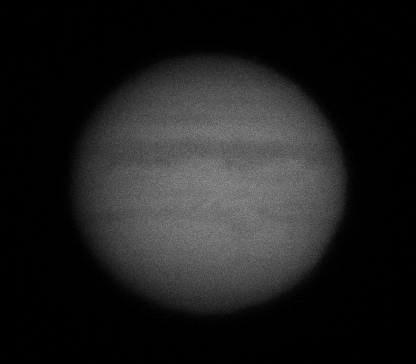
The movie plays at slow motion but it was captured at a speed of 83 frames per second. The flash lasts about 1.5 seconds and is easily visible as a point of light in the left side of the planet with a ring around in the brightest frames caused by diffraction in the optics of the telescope. The flash has structure, it lightens, decays and brightens again which are signatures of impact fragmentation in the upper atmosphere of the planet. The movie is in black and white but it was captured using a red filter. Credit: E. Chappel.
Images
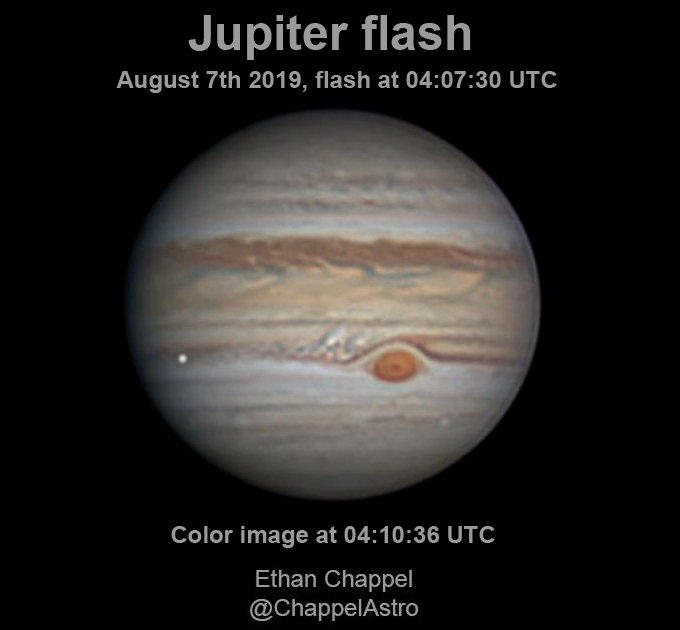
Image of Jupiter processed from images obtained by Ethan Chappel shortly after the impact. An image of the flash produced by the impact has been included at its right location over the colour image. Credit: E. Chappel
Download high resolution image: https://www.europlanet-society.org/wp-content/uploads/2019/09/Impact_color_composite_image.jpg
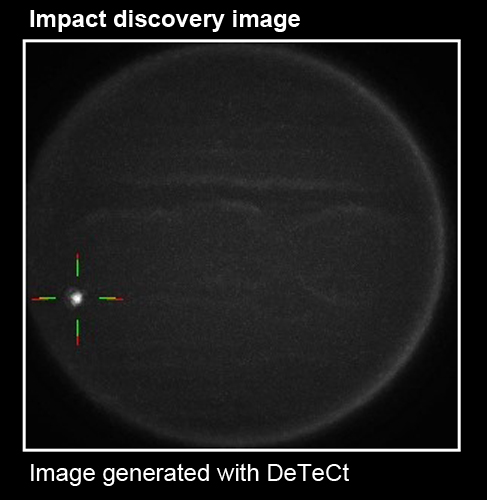
Discovery image: This image was produced by the software DeTeCt when analyzing one of the several video observations obtained by Ethan Chappel. The software identified and highlighted the location of the impact flash. DeTeCts performs differential images of a video while it corrects the position of each frame from distortions caused by atmospheric turbulence. E. Chappel/R. Hueso/M. Delcroix/DeTeCt
Download high resolution image: https://www.europlanet-society.org/wp-content/uploads/2019/09/Impact_Discovery_image_DeTeCt.jpg
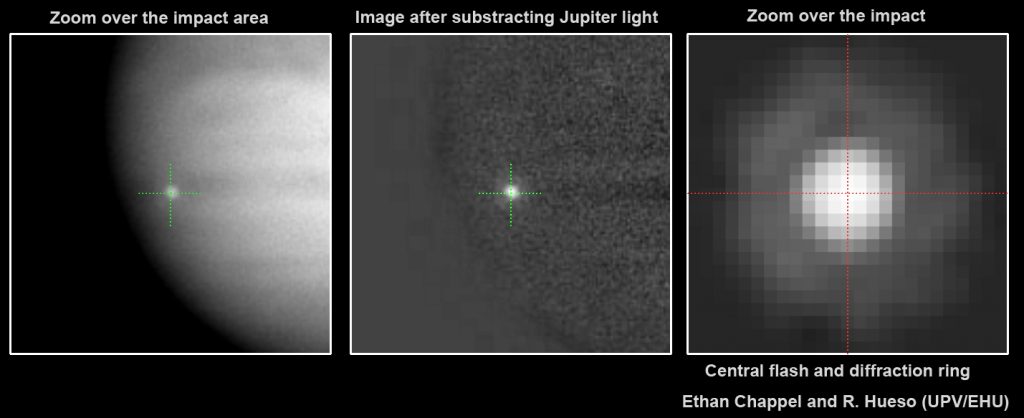
Detailed analysis of the flash from software written at UPV/EHU. The left image shows a clear image of the flash and Jupiter from adding several images of the video near the peak brightness of the flash. The image in the centre subtracts a reference image of the planet showing only the contribution from the impact flash. The right image shows a zoom of the flash at the peak of its brightness. The structure of the central flash and bright ring around are produced by optic effects in the telescope known as diffraction. Even at the scale of thie zoom the flash is a punctual source ligtening Jupiter’s atmosphere over a very small region. Credit: E. Chappel/R. Hueso
Download high resolution image: https://www.europlanet-society.org/wp-content/uploads/2019/09/Impact_Flash_Zoom.jpg
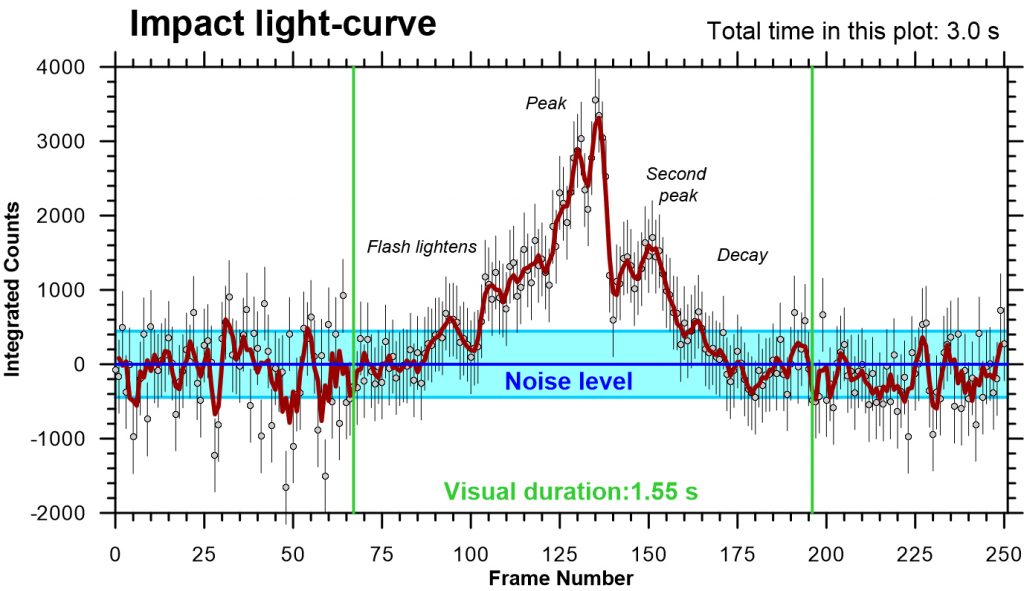
Light curve of the impact flash showing the time structure of the fireball in Jupiter’s atmosphere. E. Chappel/R. Hueso
Download high resolution image: https://www.europlanet-society.org/wp-content/uploads/2019/09/Impact_Light_curve.jpg
Science Contacts
Marc Delcroix
DeTeCt Project
delcroix.marc@free.fr
Dr. Ricardo Hueso Alonso
Escuela de Ingeniería de Bilbao
Universidad del País Vasco/Euskal Herriko Unibertsitatea
Bilbao
Tel: +34 94601 4262
ricardo.hueso@ehu.es
Media Contacts
Anita Heward
EPSC Press Officer
+44 7756 034243
epsc-dps-press@europlanet-society.org
Livia Giacomini
EPSC Press Officer
epsc-dps-press@europlanet-society.org
Adriana Postiglione
EPSC Press Officer
epsc-dps-press@europlanet-society.org
Notes for Editors
DeTeCt
Since 2011, UPV/EHU scientists led by Ricardo Hueso in Spain have made software available for amateurs to be used on their Jupiter acquisition videos with the aim to detect potential flashes resulting from small bodies impacts in Jupiter atmosphere.
In 2012, amateur astronomer Marc Delcroix from France developed the project beyond flash detection to collecting analysis by amateurs using the software in order to refine the impact frequency estimations, launching the DeTeCt project. Since then, several evolutions piloted by professional and amateur resources improved the project and more than 110 000 acquisitions have been analysed. The project has been funded by the Europlanet 2020 Research Infrastructure through the European Union’s Horizon 2020 research and innovation programme under grant agreement No 654208. http://astrosurf.com/planetessaf/doc/project_detect.shtml
EPSC-DPS Joint Meeting 2019
The 2019 Joint Meeting (www.epsc-dps2019.eu) of the European Planetary Science Congress (EPSC) of the Europlanet Society and the Division for Planetary Sciences (DPS) of the American Astronomical Society (AAS) will take place at the Centre International de Conférences de Genève (CICG), Geneva, Switzerland, from Sunday 15 to Friday 20 September 2019. More than 1950 abstracts have been submitted and over 1500 planetary scientists from Europe, the US and around the world are expected to attend the meeting, making it one of the largest gatherings of planetary scientists held in Europe to date.
The EPSC-DPS Joint Meeting 2019 will be the third time that EPSC and the DPS Annual Meeting have been held together.
Follow:@europlanetmedia#EPSCDPS2019
Europlanet
The Europlanet Society, launched in September 2018, is an organization for individual and corporate members to promote the advancement of planetary science and related fields in Europe. The Society provides Europe’s planetary science community with a platform to exchange ideas and personnel, share research tools, data and facilities, define key science goals for the future, and engage stakeholders, policy makers and European citizens with planetary science. The Europlanet Society is the parent organisation of the European Planetary Science Congress (EPSC).
Europlanet Society website: www.europlanet-society.org
EPSC-DPSC 2019 Joint Meeting 2019 website: www.epsc-dps2019.eu
DPS
The Division for Planetary Sciences (DPS), founded in 1968, is the largest special-interest Division of the American Astronomical Society (AAS). Members of the DPS study the bodies of our own solar system, from planets and moons to comets and asteroids, and all other solar-system objects and processes. With the discovery that planets exist around other stars, the DPS has expanded its scope to include the study of extrasolar planetary systems as well.
The AAS, established in 1899, is the major organization of professional astronomers in North America. The membership (approx. 7,500) also includes physicists, mathematicians, geologists, engineers, and others whose research interests lie within the broad spectrum of subjects now comprising contemporary astronomy. The mission of the AAS is to enhance and share humanity’s scientific understanding of the universe, which it achieves through publishing, meeting organization, education and outreach, and training and professional development.

